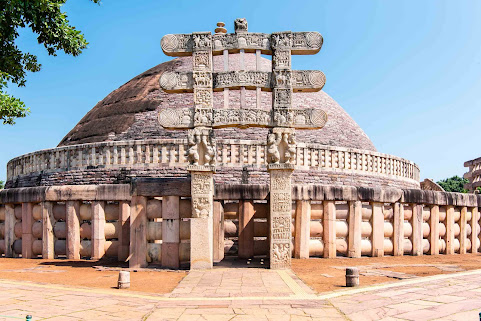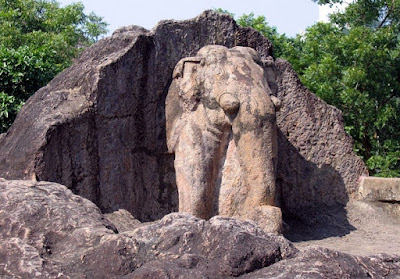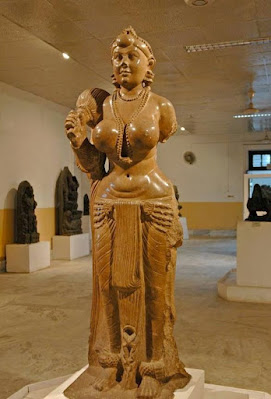BPSC Mains Answer Writing (GS - 1: History)
Pala Art & Architecture
Discuss the features of Mauryan Art and Architecture and its relationship with Buddhism. (64th BPSC 2019)
Approach
- Brief introduction about Maurya dynasty.
- Different art forms of Mauryas under different headings.
- Contribution of Ashoka and its relationship with Buddhism.
In 321 BC, Chandragupta Maurya established Maurya dynasty with the help from Chanakya (Kautilya) after overthrowing Nanda dynasty. It was the most powerful dynasty of the ancient India and brought almost entire Indian sub-continent under a single rule.
Apart from the political changes that happened in the Gangetic valley in the 4th century BC, it also witnessed the change in religious and social scenario as a part of Shramana movement which got patronage of Kshatriya rulers who had grown wary of Brahmanical supremacy.
As the Mauryas established their power, they too gave parronagew to Shramana tradition especially to Buddhism (mainly by Ashoka and his successors) and it had a great influence on Mauryan Art and Architecture.
Mauryan Art and Architecture
Mauryan Art and Architecture can be classified under two major headings -
- Court Art
- Popular Folk Art
The Court Art of Mauryas included the architectural works commissioned by Mauryan rulers for political as well as religious reasons. These includes -
- Royal Palace building
- Pillars
- Stupas
Whereas the Popular Folk Art includes the art for commissioned by Mauryan rulers as well as those commissioned at individual level. These included -
- Caves (Rock-cut Caves)
- Sculptures
- Pottery
Royal building (Palace)
- Megasthenes described Mauryan palace at Patliputra as it was as splendid as that in the capital of Iran.
- Chinese traveler, Fa Hien called it as God gifted monument.
- The principal material used during the Mauryan period was wood.
- For example - Chandragupta Maurya's wooden palace with 84 lithic pillars excavated at Kumhrar.
- 80 pillars assembly hall was also excavated here at Kumhrar.
- The pillars are decorated with gold vines and silver birds.
Pillars
- Mauryan pillars were characterised by their monolithic structure which were made up of either Red Sandstone (from Mathura) or Buff Sandstone (from Chunar).
- They were highly polished.
- The average height of the pillar is 40 ft.
- Most of the Mauryan pillar was erected by Ashoka.
- Mauryan pillars mainly comprise of 4 parts
- Shaft - A long shaft formed the base, which is monolithic, i.e., it is made up of a single piece of stone.
- Capital - On top of the Shaft lay the capital, which is either lotus shaped, or bell shaped.
- Abacus - Above Capital, there is a circular or rectangular base which is known as abacus upon which the capital figure was installed.
- Capital figure (Crowning animal) - Figures of some animals like lion, bull, elephant, etc was installed on the Abacus.
- Example - Saranath Pillar (Crowning animal - 4 lions), Lion Pillar of Lauriya Nandangarh, Bull Capital of Rampurva, Sankisa pillar (Crowning animal - Elephant), etc.
Purpose of the Pillar -
1. Before Kalinga War
- It was erected to commensurate victory.
- It was also used for serving the imperial sermons, orders and commands.
2. After Kalinga War
- It was meant for spreading the message of Dhamma.
- For example - The major rock edict II & XI of Ashoka gives a description about what Dhamma is (doctrine of Buddhism),
- It was erected to depict/celebrate the important life events of Buddha.
- For example - Saranath pillar indicated Dharmachakra Parivartan (which means turning the wheel of law). It indicates the 1st sermon of Gautam Buddha.
- Stupas were the burial mounds prevalent in India from the vedic period.
- During the period of Ashoka, the art of Stupa building reached its climax and almost 84,000 stupas were erected during his period.
- Stupas were half dome shaped (hemispherical) structure which is known as Anda surrounded by wooden fencing (Vedica) and Toranas where Jataka Stories were written.
- Later, these wooden fencing was replaced by stone fencing.
- A Stupa generally consists of following -
- Anda - It is hemispherical mound.
- Medhi - Relics of Buddha was placed in Medhi.
- Chatras - The three discs/umbrellas of chatras at the top of the Stupa represents the three gems of Buddhism, i.e., Buddha, Dhamma and Sangha.
- Yatri - It represents the axis in which the Chatras was attached.
- Harmika - It was the central pillar which supports the triple umbrella form (Yatri and Chatras).
- Pradakshina Path - It was a pathway meant for devotees to walk around the Stupa.
- Vedica - It was the boundary wall up on which Jataka Kathas were written. Earlier Vedicas were made up of woods but later stones were sued to make vedicas.
- Toranas - It is the gateway of the Stupa. There were 4 Toranas in a Stupa depicting 4 important life events of Buddha.
- Material used in the construction of Stupa - The core of the Stupa was made of unburnt brick while the outer surface was made by using burnt bricks which were then covered with thick plaster.
- Example - Sanchi Stupa (MP), Piprahwa Stupa (UP), etc
Caves (Rock Cut Caves)
- Mauryan rock cut caves were characterised by highly polished interior with decorative gateway (semi-circular facade shaped entrance were created with jaliworks).
- They were meant for Buddhist Monks as well as for Jain and Aajivika monks.
- Example - Lomas Rishi cave, Sudama Cave (in Barabar & Nagarjuni Hills, Gaya, Bihar), Dhauli Cave (Odisha).
- In front of Dhauli cave, a large elephant structure was created by Mauryas.
- Most of the caves were created by Ashoka and his grandson Dasharath.
Sculptures
- Two of the most famous sculptures of Mauryan period are those of Yaksha and Yakshi.
- They were the objects of worship to all the three religions - Hinduism, Buddhism and Jainism.
- Example - Example of Yakshi found at Didarganj, Patna.
Pottery
- The characterstics pottery of Mauryas was Northern Black Polished Ware (NBPW).
- They were made with fine particles of clay and was created on a fast-moving wheel which resulted into even shaped and smooth pottery which was highly polished and coloured with black.
- They were used as a luxurious item.
Relationship with Buddhism
After the Battle of Kalinga, Ashoka became the follower of Buddhism. Thus, the Buddhism influence can be clearly seen on their art forms. During his time period, almost 84,000 Stupas (worship place of Buddhism) were erected. Also, after accepting Buddhism, Ashoka used pillars to spread the message of Dhamma (doctrine of Buddhism). For example - In Major Pillar Edicts II and XI, Ashoka tried to give description about dhamma policy. He defines Dhamma as minimum of sins, many virtues, compassion, liberty, truthfulness and purity. Apart from that Mauryas constructed many Vihars & Chaityas and Caves for Buddhist monks.
Thus, these shows a clear relationship between Mauryan Art and Architecture with Buddhism.
Click here, for Pala Art & Architecture
Click here, for Patna Kalam
Other questions related to Mauryan Art & Architecture
- Throw light on Mauryan Art and analyze its impact on Bihar. (60-62 BPSC 2018)
- Discuss the Salient features of Mauryan Art. (53-55 BPSC 2012)
- Analyse the salient features of Mauryan Art and Architecture. (47 BPSC 2007)
- Critically examine the chief characteristics of the Mauryan Art. (45 BPSC 2002)
- Identify the main features of the Mauryan Art as found from Bihar. (42 BPSC 1999)
- What are the distinctive features of Mauryan Sculpture? (40 BPSC 1995)
Notes to boost your Preparation
Optional Notes
Note - This is my Vision IAS Notes (Vision IAS Class Notes) and Ashutosh Pandey Sir's Public Administration Class notes. I've also added some of the information on my own.
Hope! It will help you to achieve your dream of getting selected in Civil Services Examination 👍













